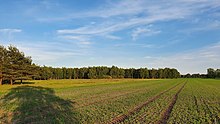Snail stairs
|
Snail stairs
|
||
|
Snail stairs |
||
| location | South-east of Sittensen , Rotenburg (Wümme) district , Lower Saxony | |
| surface | 140 ha | |
| Identifier | NSG LÜ 105 | |
| WDPA ID | 165444 | |
| Geographical location | 53 ° 14 ' N , 9 ° 37' E | |
|
|
||
| Sea level | from 34 m to 37 m | |
| Setup date | December 16, 1984 | |
| administration | NLWKN | |
The Schneckenstiege is a nature reserve in the Lower Saxony community of Stemmen in the joint community of Fintel in the Rotenburg (Wümme) district .
General
The nature reserve with the sign NSG LÜ 105 is about 140 hectares . It is almost completely part of the FFH area “Wümmeniederung” and the EU bird sanctuary “Moore bei Sittensen”. In the north it borders on the landscape protection area “ An der Schneckenstiege ”, through which it is networked with the nature protection area “ Wümmeniederung mit Rodau, Wiedau and Trochelbach ”. This is followed by the connected nature reserves “ Ekelmoor ” and “ Tister Bauernmoor ”. To the east is the “ Obere Wümmeniederung ” nature reserve , and to the south-west is the “ Kinderberg und Stellbachniederung ” nature reserve . The area has been a nature reserve since December 16, 1984. The Nature Conservation Ordinance was updated on January 1, 2019. The size of the area was adjusted from 148 hectares to 140 hectares. The responsible lower nature conservation authority is the Rotenburg (Wümme) district.
description
The nature reserve is between Scheeßel and Tostedt in the Wümmeniederung . The nature reserve is part of the Königsmoor, a raised bog area. The raised bog is heavily modified by drainage . In its northern and eastern part, the nature reserve is predominantly characterized by bog forests with downy birch , sand birch and Scots pine and open land areas with transitional moors with peat moss-rich sedge and cotton grass beds and moist heather areas . The forests have a high proportion of old and dead wood . The open land areas are partially covered with bushes. In some cases, former peat cuttings can be found, which are often heavily silted up . In the southern part there are agricultural areas in the form of grasslands with different intensities of use and arable land . In the nature reserve settle among other peat mosses , bells and heather , cranberry , white beak-sedge , bog , thread bulrush , water ragwort and ordinary adder's tongue .
The nature reserve is a habitat among other crane , black woodpecker , great spotted woodpecker , woodcock , red-backed shrike , wood lark , skylark , Redstart , Tree Pipit , Whitethroat , wood warbler , yellowhammer , Stonechat and yellow wagtail .
The moor area is drained via various water courses to the Wümme . In the east, the nature reserve is bounded by the Königsgraben, which here forms the border with the Harburg district. The nature reserve is completely surrounded by agricultural land.
Web links
- "Schneckenstiege" nature reserve in the database of the Lower Saxony State Office for Water Management, Coastal and Nature Conservation (NLWKN)
Individual evidence
- ↑ Wümmeniederung , profiles of the Natura 2000 areas, Federal Agency for Nature Conservation . Retrieved August 25, 2020.
- ^ Moore near Sittensen , profiles of the Natura 2000 areas, Federal Agency for Nature Conservation. Retrieved August 25, 2020.




